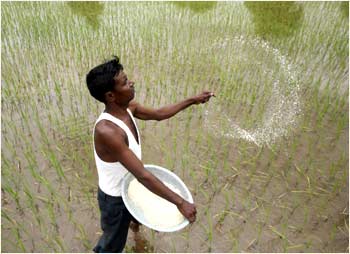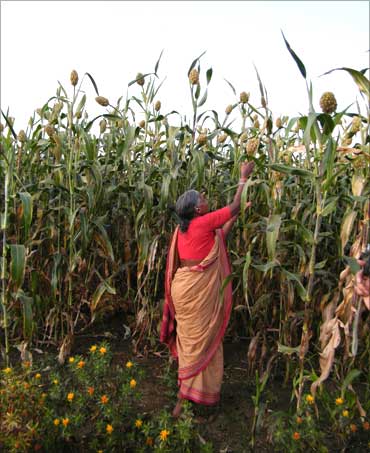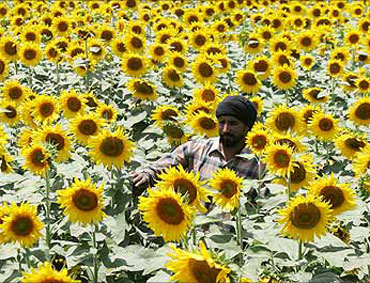 | « Back to article | Print this article |
Of Kisan Swaraj and farmer suicides
Even though life swirls hectically around him all day Lal Bhadhur Shastri's likeness, beside Regal cinema in South Mumbai, seems to go unnoticed.
Even those who may pause to read the 'Jai Jawan, Jai Kisan' metal inscription, on the stone platform which carries the statue, tend to be puzzled.
Unless you are over 50 years of age you cannot have any memories of the time when these words carried an inspirational ring.
It seems eons ago that the song Mere desh ki dharti sona ugale, ugale hirey moti. . ., from the film Upkaar, felt like an anthem. In fact it was just about 43 years ago.
At that time if someone had predicted a day when films would tell the story of farmers' suicides -- they would have been deemed to have a sick imagination. In 1965, India inaugurated the Green Revolution of hybrid seed, fertilizers and irrigation -- and a lot of us grew up thinking that India will always be self-sufficient in food.
Now, in the time of Peepli Live it seems tragically poignant that Shastri, India's second prime minister, made veneration of farmers his rallying call.
Click NEXT to read on. . .Of Kisan Swaraj and farmer suicides
Even the organisers of a Kisan Swaraj Yatra have announced that their campaign will be launched on Gandhi Jayanti this year -- omitting to highlight that October 2 is also the birthday of Shastri.
Why do Shastri's image and his slogan seem so impossibly idealistic, even unhelpful, today? It could be because he belongs to a time when economy, politics -- even life itself -- were not quite so horrendously complicated. Or at least that is how it seemed.
By contrast, the Kisan Swaraj Yatra's revival of 'Jai Kisan' is loaded with challenges because it must contend with a tangled coil.
Some constituents of this initiative tend to depict the Green Revolution as an unmitigated disaster. But this does not ring true to those who have grown up knowing that the green revolution gave India bumper crops of grains.
Thus the Yatra activists have to find creative ways of communicating critical information about the multi-shaded truths about our agricultural past, present and future.
Over the years there has been extensive media coverage of the down side of the Green Revolution. Those high yielding varieties of seeds required much higher volumes of water and were typically less resistant to pests -- thus requiring pesticides and other inputs which made agriculture much more capital intensive.
These factors, along with mono-cropping cultivation paved the way for some of the distress conditions that are causing farmers to kill themselves.
Click NEXT to read on. . .Of Kisan Swaraj and farmer suicides
But does the Kisan Swaraj Yatra have answers? Its exhortation is that we should all "Say NO to GMOs & Chemical Pesticides, Bring in Ecological Farming" in order to save farmers. Promoted by the Alliance for Sustainable and Holistic Agriculture (ASHA), the Yatra is essentially fighting for the rights of 70% of India's population who still depend largely on agriculture for their livelihood.
This pitches the promoters of the Yatra in direct conflict with powerful elements in the private sector and in government who argue that India's future depends on shifting the bulk of its population to non-agricultural livelihoods.
So one of the biggest challenges for such a campaign is how to avoid getting mired in futile contestation over the question of just how many Indians' livelihood can be fully supported by agricultural lands.
ASHA's credibility may well depend on not offering a magical answer to this puzzle. Instead it is poised to play two critical roles.
One is to raise a public outcry against pushing farmers out of agriculture without generating an adequate volume of alternative livelihoods.
The second is to highlight the crisis of agricultural productivity and thus campaign for various forms of 'holistic agriculture' which would both revive soil quality and give us food that is not laced with the toxins of pesticides and fertilizers.
Click NEXT to read on. . .Of Kisan Swaraj and farmer suicides
If there were sufficient avenues for farmers to move to non-agricultural livelihoods or business enterprises -- more than one-and-a-half lakh (150,000) farmers would not have committed suicide over the last decade and a half.
The Kisan Swaraj mobilisation is based on the observation that when farmers are pushed out of agriculture in a distress situation they tend to move into even more vulnerable positions -- either in rural or urban areas.
A spokesperson for ASHA points out that in Andhra Pradesh most of the new entrants in business, educational, scientific, industrial occupations or enterprises have been from the coastal areas where agriculture has gradually became a more secure livelihood.
Thus the Kisan Swaraj Yatra aims to raise a public demand for generating livelihood security in agriculture -- as a necessary pre-requisite for creating more non-agricultural economic opportunities.
In this context the primary objective of the Kisan Swaraj platform is to impart information about the kind of agriculture that could provide a truly sustainable green revolution.
This includes lobbying for an up-scaling of the Community-Managed Sustainable Agricutlure (CMSA) which has been supported by the government of Andhra Pradesh and shown excellent results.
Click NEXT to read on. . .Of Kisan Swaraj and farmer suicides
Such techniques aim to restore farm ecology through means that ensure a beneficial mix of insects, birds, bees, earthworms as well as the regeneration of natural pest-resistance.
Similarly, System of Rice Intensification (SRI) requires less water and less expenditure while giving higher yields -- particularly to small and marginal farmers.
Spreading information about such successes is enough of a task. But as the Kisan Swaraj Yatra wanders through 20 states its much tougher challenge will be to find effective ways of convincing people that tinkering with the old Green Revolution model won't do and instead there is need for a entirely new mindset.
Organisers of the Kisan Swaraj Yatra draw their inspiration from Mahtma Gandhi's Salt Satyagraha, the historic Dandi March. That's a dauntingly tough act to follow.
In a far more complex world it is frighteningly difficult for any movement to attain that level of simplicity and directness. What, for instance, would be today's equivalent for that pinch of salt which Gandhiji lifted on the sea shore and in so doing challenged an empire?




